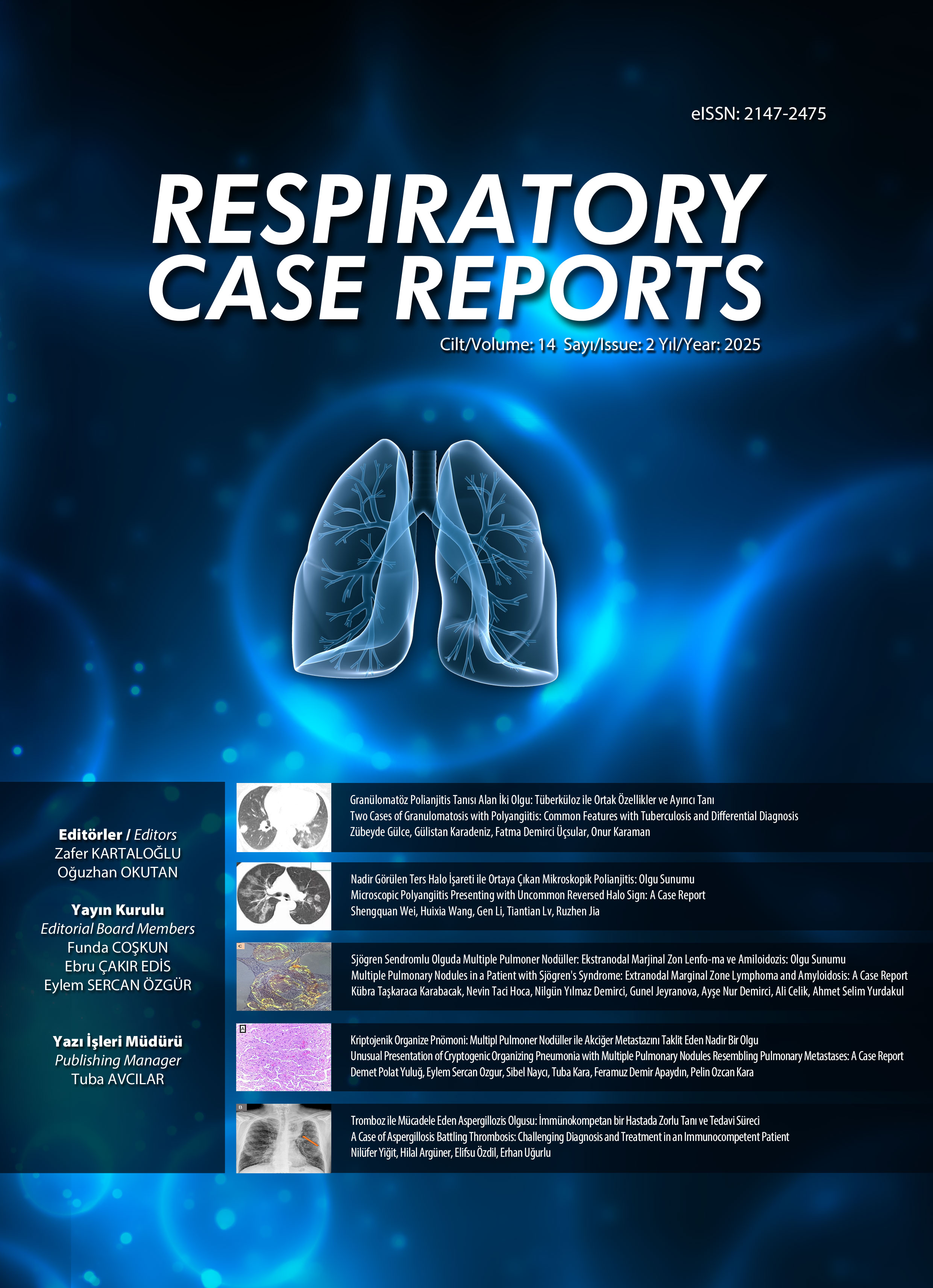e-ISSN 2147-2475

Volume: 13 Issue: 2 - June 2024
| CASE REPORT | |
| 1. | Brucellosis Mimicking Lung Cancer: A Case Report Gokce Kulah, Tayfun Caliskan, Kadir Canoğlu, Özge Atış, Mustafa Çarkçı doi: 10.5505/respircase.2024.68335 Pages 67 - 70 Brucella is a gram-negative intracellular microorganism that can infect humans when they come into contact with infected animals or consume cer-tain foods, such as raw milk, unpasteurized cheese or undercooked meat. Brucellosis frequently develops with lung involvement. We present here a case who presented with brucellosis mimicking lung cancer. Although pulmonary involvement is a rare manifestation of brucellosis, it should be considered in the presence of persistent fever, arthralgia and pulmonary symptoms in areas where the disease is widespread. Lung cancer is carefully investigated by physicians due to its prevalence in the community and the high mortality rates involved, while brucel-losis is less common in the community and has a relatively better prognosis. Brucellosis may be missed in patients lacking accurate anamnesis. Prolonged examination and treatment processes may lead to unnecessary expenses and the pro-gression of the disease due to late diagnosis. |
| 2. | Liquid Nitrogen-Laced Biscuit Consumption Leads to Respiratory Distress: A Case Report and Review of Literature Ashok Arbat, Gauri Gadge, Sweta Chourasia, Parimal Deshpande, Swapnil Bakamwar doi: 10.5505/respircase.2024.82246 Pages 71 - 77 A recent trend is attracting consumers that take the form of smoky liquid nitrogen (LN2) food products. However, due to improper handling and a lack of knowledge of the potential health hazards, people are becoming prey to such repercussions as respiratory distress, skin necrosis and gastrointestinal injuries. We present here a case of a teenage boy with allergic rhinitis who was affected by the extreme cold generated during the consumption of Nitrogen biscuit who developed cough and exer-tional dyspnea, and who didnt respond to treatment in the local clinic and went on to suffer frequent bouts of illness. Upon presentation, his spi-rometry values were FEV1 65%, FVC 69% and FEV1/FVC 87.3 and a chest X-ray revealed prominent bilateral bronchovascular marking. The pa-tient was given an inhaler containing corticosteroid and bronchodilator to relieve the bronchocon-striction, and follow-up spirometry after four months showed improvement. Awareness of risks associated with LN2-infused food at the point of sale is needed. |
| 3. | Diet-treatable Cause of Hemoptysis: Lane Hamilton Syndrome Esra Arslan Aksu, Oğuz Karcıoğlu, Oğuz Uzun doi: 10.5505/respircase.2024.73604 Pages 78 - 81 Idiopathic pulmonary hemosiderosis is a rare cause of alveolar hemorrhage that is referred to as Lane Hamilton Syndrome when co-occurring with coeliac disease. Although the underlying cause is still unknown, the improvements brought by a gluten-free diet point to a shared pathogenesis. An 18-year-old female underwent bronchoscopy after presenting with complaints of recurrent hemoptysis attacks, revealing hemosiderin-laden macrophages pointing to alveolar hemorrhage. The presence of anti-endomysium IgA in the serum, substantiated by an endoscopic biopsy, was indicative of Celiac Disease. Her symptoms improved dramatically upon starting a gluten-free diet, but the patient subse-quently died from an alveolar hemorrhage due to non-compliance with the diet. |
| 4. | Methamphetamine-induced Fibrotic Hypersensitivity Pneumonitis Hülya Abalı, Fatma Tokgoz Akyil, Neslihan Fener doi: 10.5505/respircase.2024.87360 Pages 82 - 85 We present here a case of fibrotic hypersensitivity pneumonitis in a patient with a 7-year history of daily inhaled crystal methamphetamine abuse. The patients history of chronic exertional dyspnea attributable to progressive methamphetamine abuse, family history and autoimmune features pointed to methamphetamine as the initiator of fibrotic hypersensitivity pneumonitis. After excluding other causes, the patient's clinical, laboratory, radiological and histopathological findings indicated that the fibrotic hypersensitivity pneumonitis had been induced by methamphetamine. |
| 5. | A Case of Pulmonary Arterial Air Embolism: A 10-hour Cruise Uğur Yüregir, Ege Güleç Balbay, Mustafa Boğan, Ali Can Kara doi: 10.5505/respircase.2024.46548 Pages 86 - 89 Air embolism is a condition that often goes unnoticed, and although it is potentially life-threatening, it is rarely reported. The condition usually develops iatrogenically and resorbs spontaneously, although complications such as pulmonary edema and parenchymal destruction can develop. In our case, in lung tomography images taken 10 hours apart, the air seen in the pulmonary artery and right atrium disappeared, while areas of increasing consolidation were identified in the left lung. It is thought that air embolisms may be a cause of pneumonia etiologies in patients undergoing intravenous (IV) procedures, while other studies have referred to the condition, considered pneumonia, as an inflammatory process that develops due to the destruction following an air embolism. There is a need to investigate the frequency of complications and pneumonia in cases that develop air embolisms following IV procedures. |
| 6. | Solitary Fibrous Tumor of the Pleura: A Case Report Emine Ayan, Mustafa Çolak, Ali Karakılıç, Zafer Erol, Nurhan Sarioglu doi: 10.5505/respircase.2024.43760 Pages 90 - 94 Solitary fibrous tumors of the pleura are extremely rare mesenchymal tumors that originate from the visceral or parietal pleura, accounting for less than 5% of all pleural tumors. Solitary fibrous tumors are diagnosed based on clinical, radiological and needle biopsy findings. They are often asymptomatic and can reach very large sizes in the thorax, upon which they may produce such symptoms as cough, chest pain, dyspnea and hemoptysis. These tumors are generally benign, but are identified as malignant in 1020% of cases, and carry the risk of recurrence, making early diagnosis very important. The treatment option is total resection followed by close follow-up. We present here a very rare case with a solitary fibrous tumor of the pleura. |
| 7. | Diagnosis of Diffuse Pulmonary Hemorrhage by Ultrasonography: A Case Report Nalan Kozacı, İsmail Erkan Aydın, Tuğçe Erşahin, Büşra Taşkıran doi: 10.5505/respircase.2024.49260 Pages 95 - 99 A 72-year-old male patient was admitted to the emergency department with a complaint of a rash covering his entire body and shortness of breath. Aside from the petechial rash covering his body, the patient was also found to have bleeding in the mouth and gums, and tachypnea. A bedside point-of-care ultrasound (POCUS) revealed multiple and confluent B lines, a pleural line abnormality, the disappearance of A-lines, a subpleural hypoechoic area, hepatization, shred sign and pleural effusion, predominantly in the 3rd, 4th and 5th zones of the right lung and the 3rd and 4th zones of the left lung. A stratosphere sign was detected in M Mode. The patient was diagnosed with diffuse pulmonary hemorrhage with POCUS and clinical findings. |
| 8. | Postoperative Negative Pressure Pulmonary Edema Elif Karasal Gulıyev doi: 10.5505/respircase.2024.30643 Pages 100 - 103 Negative pressure pulmonary edema (NPPE) can result from the increased intrathoracic and hydrostatic pulmonary pressure associated with forced inspiration against acute closures of the upper respiratory tract in the postoperative period. The associated postoperative complications include atelectasis, pneumonia and embolism. It should be kept in mind that NPPE is the cause of desaturation in the postoperative period in young patients. In patients who have undergone upper respiratory tract surgery, edema in the upper respiratory tract increases the risk of collapse, although rapid clinical response can be achieved in such patients with early diagnosis and intervention. The primary goal of treatment is to ensure the oxygenation of the patient, and non-invasive mechanical ventilation (NIMV) can be used in addition to oxygen support in some cases. NIMV, however, is contraindicated in patients who have undergone upper respiratory tract surgery, in whom full clinical response can be achieved with high-flow oxygen, methylprednisolone and diuretic treatment. |
| 9. | Meningocele Mimicking A Mass in the Lung: A Case Report Nurhan Atilla, Burcu Akkök, Fulsen Bozkuş, Tuba Bilgili doi: 10.5505/respircase.2024.76258 Pages 104 - 106 Spinal meningocele refers to the herniation of the sac containing the dura and arachnoid membrane through a vertebral column defect or a foramen, they most frequently occur in the posterior and in the lumbosacral region. On imaging an anterior spinal meningocele will resemble a posterior mediastinal mass, but since these abnormalities are sacs filled with cerebrospinal fluid, they may appear on imaging as cystic structures connected to the vertebral column. In the presented case, a lesion that resembled a mass in the lung was identified as meningocele based on detailed imaging and the opinion of the neurosurgeon. |
| LETTER TO EDITOR | |
| 10. | A Case of Infected Tracheal Diverticula Mimicking a Mediastinal Mass Savaş Gegin doi: 10.5505/respircase.2024.64935 Pages 107 - 109 Abstract | |












